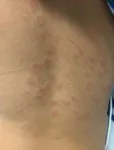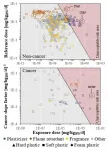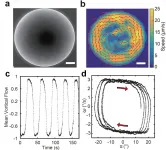Researchers discover potential new therapeutic targets on SARS-CoV-2 Spike protein
2021-02-22
(Press-News.org) UNIVERSITY PARK, Pa. -- The COVID-19 pandemic has prompted considerable investigation into how the SARS-CoV-2 Spike protein attaches to a human cell during the infection process, as this knowledge is useful in designing vaccines and therapeutics. Now, a team of scientists has discovered additional locations on the Spike protein that may not only help to explain how certain mutations make emerging variants more infectious but also could be used as additional targets for therapeutic intervention.
"Significant research is underway to examine how the receptor binding domain (RBD) at the tip of the club-shaped SARS-CoV-2 Spike protein attaches to an ACE2 receptor on a human cell, but little is known about the other changes that occur in the Spike protein as a result of this attachment," said Ganesh Anand, associate professor of chemistry, Penn State. "We have uncovered 'hotspots' further down on the Spike protein that are critical for SARS-CoV-2 infection and may be novel targets beyond the RBD for therapeutic intervention."
Anand and his colleagues used a process, called amide hydrogen-deuterium exchange mass spectrometry (HDXMS), to visualize what happens when the SARS-CoV-2 Spike protein binds to an ACE2 receptor. HDXMS uses heavy water or deuterium oxide (D2O), a naturally occurring, non-radioactive isotope of water formed from heavy hydrogen or deuterium, as a probe for mapping proteins. In this case, the team placed SARS-CoV-2 Spike protein and ACE2 receptors in heavy water and obtained footprints of ACE2 on the Spike protein.
"If you put the Spike protein and ACE2 receptor into a solution that's made with D2O, the surfaces and more floppy regions on both proteins will more readily exchange hydrogens for deuterium, compared to their interiors," said Anand. "And footprints of each protein on the binding partner can be readily identified from areas where you see little deuterium and only detect normal hydrogen."
Using this technique, the team determined that binding of the Spike protein and ACE2 receptor is necessary for furin-like proteases -- a family of human enzymes -- that act to snip off the tip, called the S1 subunit, of the Spike protein, which is the next step in the virus's infection of the cell. The findings published on Feb. 8 in the journal eLife.
"The Spike proteins on the surface of the virus swivel to search and latch onto the ACE2 receptor," said Anand. "ACE2 can be likened to a hand holding strands of hair -- the Spike protein clusters. Binding to Spike stabilizes it so it can be cut by furin protease scissors. After furin proteases clip the protein, the part that remains -- the S2 subunit -- is what fuses with the cell's membranes, allowing entry into the cell."
Anand noted that researchers have already learned much about how the Spike protein and ACE2 receptor bind together, but until now no one knew how this binding relayed the message to the furins to cut the protein. He explained that the phenomenon is called allostery, meaning "action at a distance."
"Our findings show ACE2 receptor binding to SARS-CoV-2 Spike protein causes long-range changes and allosterically enhances protease cutting at the distal S1/S2 cleavage site," he said.
Anand said that researchers are currently focusing only on therapeutics that block the Spike protein from binding to the ACE2 receptor.
"In this paper, we're suggesting that's not the only vulnerability that can be targeted," he said. "Maybe the S1/S2 cleavage that is necessary for furin cleavage can serve as a new target for inhibitory therapeutics against the virus. This study also may help in explaining how mutations in emerging variants might alter dynamics and allostery of ACE2 binding, potentially increasing infectiousness of the SARS-CoV-2 virus."
INFORMATION:
Other authors on the paper include Palur V. Raghuvamsi, Nikhil K. Tulsian, Firdaus Samsudin, Xinlei Qian, Kiren Purushotorman, Gu Yue, Mary M. Kozma, Peter J. Bond and Paul A. MacAry at the National University of Singapore, and Wong Y. Hwa and Julien Lescar at the Nanyang Technological University in Singapore.
The National Medical Research Council (NMRC), Singapore, supported this research.
ELSE PRESS RELEASES FROM THIS DATE:
2021-02-22
A new study from researchers at the University of Ottawa's School of Psychology has found that using negative emojis in text messages produces a negative perception of the sender regardless of their true intent.
Isabelle Boutet, a Full Professor in Psychology in the Faculty of Social Sciences, and her team's findings are included in the study 'Emojis influence emotional communication, social attributions, and information processing' which was published in Computers in Human Behavior.
Study background: Eye movements of 38 University of Ottawa volunteer undergraduate student participants were tracked and studied, and the volunteers were shown sentence-emoji pairing under 12 different conditions where sentences could be negative, positive, ...
2021-02-22
Philadelphia, February 22, 2021--In April 2020, pediatricians began recognizing a puzzling syndrome in children involving hyperinflammation that results in an array of symptoms, including fever, gastrointestinal distress and rash. The syndrome, thought to be a post-infectious complication of SARS-CoV-2 infection, was given the name Multisystem Inflammatory Syndrome Children, or MIS-C. However, diagnosing the condition has posed challenges, as many of its symptoms, including rash, are common in many other pediatric infections.
In a study published in Open Forum Infectious Diseases, researchers at Children's Hospital of Philadelphia (CHOP) describe the ...
2021-02-22
It has long been known that several chemicals used in plastic toys in different parts of the world can be harmful to human health. However, it is difficult for parents to figure out how to avoid plastic toys containing chemicals that may cause possible health risks to their children.
Regulations and labelling schemes are different across regions and countries, and there is no international agreement on which substances should be banned from use in toy materials. For the most part, regulations and international lists of 'chemicals of concern' in toys focus on certain substance groups with known harmful properties, such as phthalates, but do not cover the wider range of chemicals found in plastic toys.
Researchers from DTU ...
2021-02-22
With the COVID-19 pandemic taking a disproportionate toll on low-income people of color, a research team headed by Marya Gwadz of the Silver School of Social Work at New York University set out to understand the ways the pandemic may put individuals at risk for adverse outcomes, and the ways they successfully adapted to and coped with the emerging pandemic, focused on those from low-socioeconomic status backgrounds who have lived with HIV for a decade or longer.
The team's newly published study explores the effects of COVID-19 on engagement in HIV care, HIV medication use and overall wellbeing during the early stages of the ...
2021-02-22
About 70% of the world's main crops depend on insect pollination. Climate change is already affecting the abundance and distribution of insects, which could cause geographical mismatches between crops and their pollinators. Crops that rely primarily on wild pollinators (e.g., crops that cannot be effectively pollinated by commercial colonies of honey bees) could be particularly in jeopardy. However, limited information on plant-pollinator associations and pollinator distributions complicate the assessment of climate change impacts on specific crops. To study the potential impacts of climate change on pollination of a specific crop in North America, we use the case of open?field ...
2021-02-22
Macrocyclic peptides are promising candidates for pharmaceuticals, but their screening is difficult. Scientists have now developed an easy-to-use, high-throughput screening assay for cyclic peptides with affinity to ubiquitin, a protein that helps to degrade proteins and induce cell death. The results could lead to novel drug candidates against cancer, according to the study published in the journal Angewandte Chemie.
Drugs based on peptides (small proteins) are often too large to pass through cell membranes. To make such peptides more compact and stable--and thus more efficient--researchers are investigating their closed versions, called macrocyclic ...
2021-02-22
This new finding may pave the way for fabricating a new class of self-driven devices and materials, such as the ability to control the rhythmic movement of soft robots without relying on electronic circuits, and for the study of microbial physiology. It has been published in the scientific journal Nature.
A fast growing and interdisciplinary field, active matter science studies systems consist of units where energy is spent locally to generate mechanical work. Active matter includes all living organisms from cells to animals, biopolymers driven by molecular motors, and synthetic self-propelled materials. Self-organisation (the process of producing ordered structures via interaction between ...
2021-02-22
A SARS-CoV-2 tracker uses publicly available sequencing data to show how the virus is changing and spreading over time. The tracker, called CovMT, was developed at KAUST and is expected to help researchers and policymakers understand the evolution of the virus's mutations. This could have implications for vaccine development, patient treatment and the implementation of restrictions.
"As new variants of the SARS-CoV-2 virus emerge, authorities around the world need to know if these, or similar variants, have entered their countries," says computational biologist, Intikhab Alam, who designed ...
2021-02-22
Treating waste brine using a self-cleaning crystallizer that runs on solar power could be an eco-friendly and efficient way to make seawater desalination more sustainable.
In desert regions, seawater desalination provides essential freshwater for drinking and agriculture. A major problem is that the process generates vast quantities of concentrated brine that is often released into nearby lakes and rivers or back into the sea, harming vegetation and marine life. "With tightening environmental regulations and increasing public awareness, there is pressure to treat brine with zero liquid discharge," says Chenlin Zhang, a Ph.D. student in KAUST. This means extracting every last drop of water while leaving behind solid mineral crystals that can be salvaged for other uses.
Crystallization ...
2021-02-22
Monoclonal antibodies are part of the therapeutic arsenal for eliminating cancer cells. Some make use of the immune system to act and belong to a class of treatment called "immunotherapies." But how do these antibodies function within the tumor? And how can we hope to improve their efficacy? Using innovative in vivo imaging approaches, scientists from the Institut Pasteur and Inserm visualized in real time how anti-CD20 antibodies, used to treat B-cell lymphoma, guide the immune system to attack tumor cells. Their findings were published in the journal Science Advances on February 19, 2021
Anti-CD20 antibodies are used in clinical practice to treat patients with B-cell lymphoma, a type of blood cancer. The treatment, often used in combination with chemotherapy, has been ...
LAST 30 PRESS RELEASES:
[Press-News.org] Researchers discover potential new therapeutic targets on SARS-CoV-2 Spike protein



